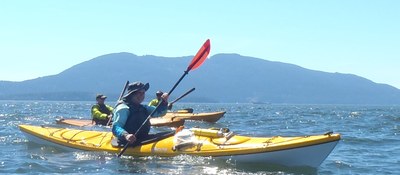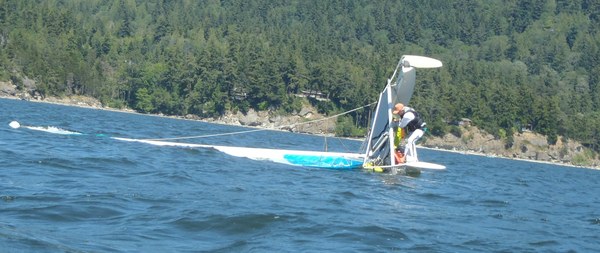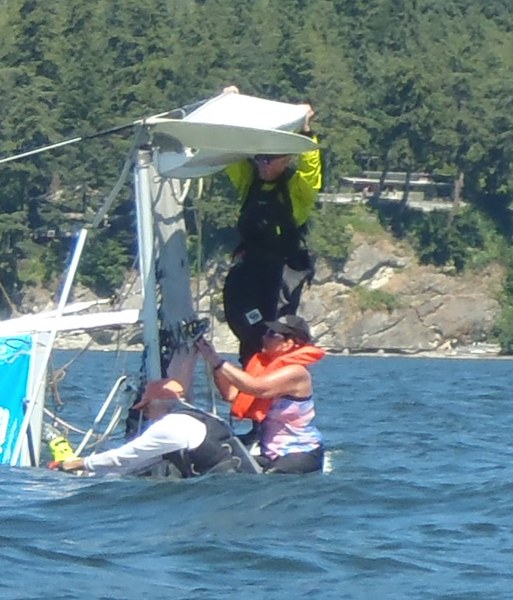
Trip Report
Sea Kayak - Chuckanut Bay
A student kayak paddle trip in Chuckanut bay that ended with a "reverse rescue".
- Sun, Jun 26, 2022
- Sea Kayak - Chuckanut Bay
- Chuckanut Bay
- Sea Kayaking
- Successful
-

- Road suitable for all vehicles
-
Our launch was at a -1ft tide and this gave an opportunity for me to learn what beaches are available at lower tides.
- Wildcat cove launch becomes a sand flat at negative tides. But the sand is firm, easy walking, and relatively clean. I've seen people drive out onto the sand to load and un-load.
- The shore along Governor's point is less interesting at low tides
- Low tides expose a nice rocky beach in the cove at Clark Point. We took our lunch break here. High tides cover this beach, leaving a more difficulty rocky landing.
- In contrast, at the small road-accessible beach in the north east corner of Chucanut bay low tides expose smooth rocks making for a more difficult landing while high tides bring the water up to a good sand and shell beach.
- The paddle-through in the south east corner was dry at the middling tide level. This needs perhaps 5ft tide or above to be passable.
This was a beautiful paddle in the interesting Chuckanut Bay. Tide went from -1ft at launch to 8ft by 6pm so was flooding all day. We took lunch in the bay at Clark Point. The two basic students took the opportunity to demonstrate their rescues. Being a warm day, everyone else took the opportunity to get in the water and practice getting back in their boat.
On return, at Governor's point, the flooding current against a northern wind created seas of 1.5ft or so. We again repeated rescues, giving the students an opportunity to go practice in slightly rough conditions and gain confidence that rescues will work in the conditions more likely to cause a capsize.
While we were doing our rescue practice, a 30' sailboat came by to check if we were in need of assistance. This is the second time that sailors have come to check on me during rescue practice. Attention and care of other boaters is always appreciated.
As we neared our launch point, Wildcat Cove, we noticed a capsized sailboat about a quarter mile off shore. Minutes before, we had seen them sailing briskly in the 10kt wind. Now, the boat is laying on it's side. I predict that we'll soon see the mast come back up and the boat sail away. A couple minutes later the boat is still on it's side. We discuss and agree we ought investigate. We are mere kayaks but our kayaks are quite sea worthy and we have skills.

We discover a man and woman clinging to the boat, which has now turned bow up and is no closer to being righted. A paddle boarder has also come out to offer assistance.
Since this is someone's incident, I don't want to take charge, but do think it possible that an extra hand or two pulling in the right direction, may get the boat back upright in a couple minutes. Brian and I, having experience sailing small boats, jump on - or in.
But we discover there are difficulties. The rope rigged to pull the boat upright requires us to stand quite tall and does not have enough slack for me to lean back and get righting leverage. Our four un-cordinated efforts cause the boat to turn from side-down to bow-down or stern down but never right side up.

Further, the woman who is not in immersion wear, reports she is getting cold. We move her to the paddle board, where she can be completely out of the water. Brian and I work to loose the sheet and lower the sail - more complex for it being an unfamiliar rig and everything in the water. After a little more flailing about, we manage to get the leverage right and the boat comes back up.
Getting the sail back up looks difficult. I think we'll need to tow the boat back. Brian suggests sailing under jib alone and I discover he is correct that this will get us back to the launch. Brian gets back in his kayak. Pat tows (newly purchased tow belt!) my kayak back, and I sail the catamaran.

I call this a "reverse rescue" because the normal case is kayakers getting rescued. For kayakers to rescue another type of boat is a reversal.
Back on shore, we debrief. Lessons learned:
- How to enter someone else's incident is unclear. Do they just need a hand or do they need me to take charge? This is different than where the incident within my group.
- Brian points out that taking time to make a plan is good practice. I jumped in, hoping that lending a hand would lead to fast recovery but this left me focused on one specific aspect, not the total situation. Sometimes, my desire to mess around with boats wins over a more deliberate approach. On this, a mild warm day with a capable group, it was all good fun.
- But Brian's right and time to form a plan may have lead us to understand that these boaters needed more than just a helping hand. They needed someone else to take charge. I think.
- Pat decided that 50' of tow rope is longer than needed for calm waters (25' to 35' is more common). There is no substitute for using your gear to discover what works and what does not.
At the beginning of our trip, we discussed that this was a warm June day, just past the solstice, and we are wearing drysuits. No one else is wearing drysuits, why are we?
It is not because they are necessary for safety. There is no hard rule about what is required for safety, one must consider the total situation. On a warm day, with a team of competent paddlers, in these calm waters, I may choose to wear shorts and a tee-shirt. Capsize is unlikely, quick recovery from a capsize is likely. The slight reduction in safety may be worth the increase in comfort.
What is unsafe, and this may be a hard rule, is to go upon the water with out the ability to recover from capsize. There are many components to a recovery plan such as well practiced quick recover, immersion wear to extend comfort in water in case recovery is complex, or a small emergency vessel in case your main vessel can't be recovered. Again, the total situation must be considered.
We wore dry suites as practice. Some warm sunny days, the potential for an extended time in the water indicates wearing a drysuit so it is important to figure out how to be comfortable. If you can be comfortable, that will reduce the temptation to leave off your drysuit when you really should wear it. Further, on this day, dry suits encourage people to get into the water for rescue practice. Finally, wearing drysuits made it possible for Brian and I to spend time in the water figuring out how to get that sail down. Our drysuits gave us greater safety buffer while assisting the sailors.
 Tom Unger
Tom Unger